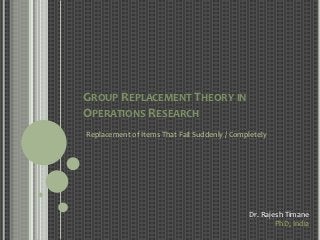
Group Replacement Theory in Operations Research
- 1. GROUP REPLACEMENT THEORY IN OPERATIONS RESEARCH Replacement of Items That Fail Suddenly / Completely Dr. Rajesh Timane PhD, India
- 2. REPLACING IN GROUPS There are certain items which do not deteriorate but fail completely after certain amount of use. These kinds of failures are analysed by the method called as group replacement theory. http://www.rajeshtimane.com Here, large numbers of items are failing at their average life expectancy. This kind of items may not have maintenance costs as such but they fail suddenly without any prior warning. Also, in case of sudden breakdowns immediate replacement may not be available.
- 3. EXAMPLES It should be noted that, group replacement does involve periodic simultaneous replacements along with individual replacements in between. http://www.rajeshtimane.com Few examples are fluorescent tubes, light bulbs, electronic chips, fuse etc.
- 4. WHY REPLACE IN GROUP It is found that replacing these random failing items simultaneously at specific intervals is economical as compared to replacing them only when an item fails. A long period between http://www.rajeshtimane.com group replacements results in increase in cost of individual replacements, while frequent group replacements are definitely costly. There lies the need to balance this and find an optimum replacement time for optimum cost of replacement.
- 5. ILLUSTRATION A factory has 1000 bulbs installed. Cost of individual replacement is Rs. 3/- while that of group replacement Re. 1/-per bulb respectively. It is decided to replace all the bulbs simultaneously http://www.rajeshtimane.com at fixed interval & also to replace the individual bulbs that fail in between. Determine optimal replacement policy. Failure probabilities are as given below: Month 1 2 3 4 5 Monthly Failures (%) 10 25 50 80 100 Find complete solution and full article at: http://www.rajeshtimane.com/359/academics/group-replacement-theory.html
- 6. THANK YOU !
